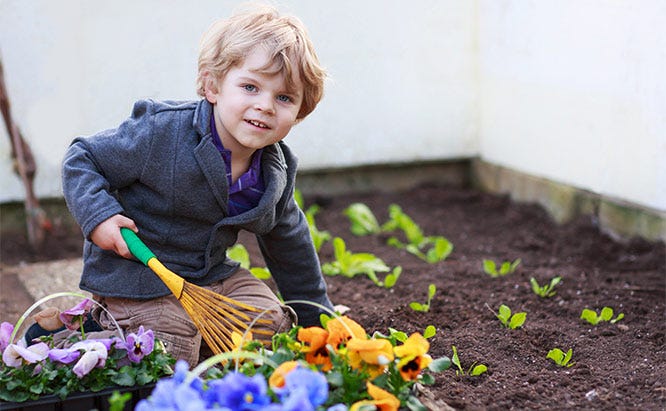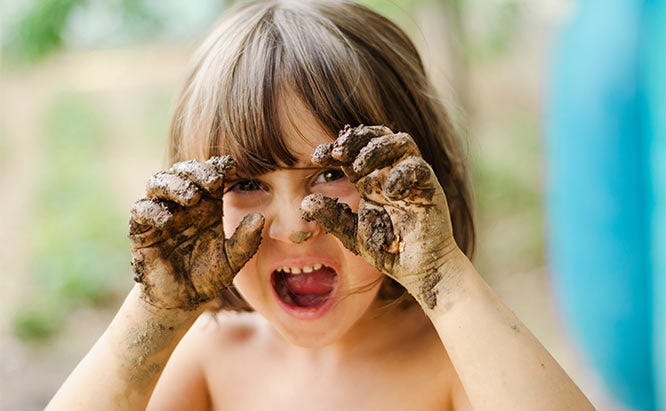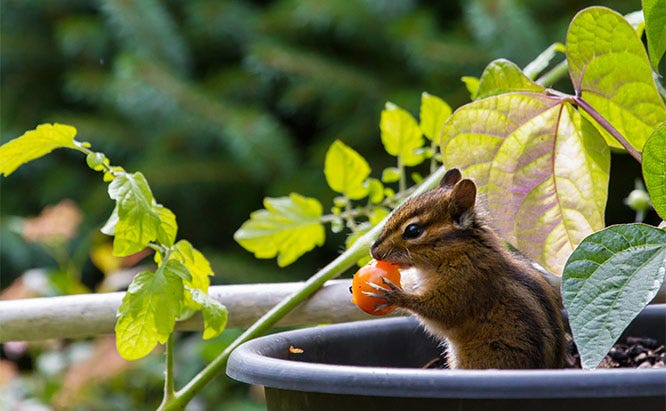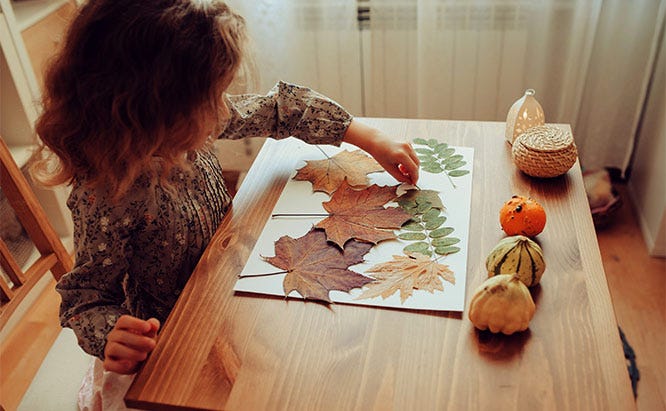
For many adults, gardening is a continual learning experience as we discover growth cycles, pest problems and best practices for maximum output. As you learn all this great information, why keep it to yourself? Instead, invite your kids or grandkids to join you!
We know what you’re going to say! “My kids would never do that! They’re too distracted by the TV. They’ll complain it’s too hot.” You’re right, youngsters will try their best to get out of gardening, but we aren’t ready to give up so easily!

There are lots of great ways to help your youngsters grow to love gardening and the great outdoors. Even the most smartphone-addicted kid can find a love for gardening, especially if an adult like you offers support and guidance!
Let’s take a look at how you can make gardening for kids happen:
Remember Kids Will Be Kids
The most important rule to getting a youngster into gardening is to understand that, at least at first, you’ll likely have an unwilling participant. Your youngster will think there’s better things to do, so it’s your job to make sure a good time is had by all. Likewise, you need to understand that kids will be kids. Expect complaints and whining one minute, and then total fascination the next. The key is appealing to their sense of fun, so here are some things to remember:
- Dirt & Water: Every garden involves digging and watering. If your youngster starts playing in the mud or over-spraying with the hose, let it happen. Don’t get worried if they get dirty!
- Tools: Providing your young gardener with his or her own set of tools can be a lot of fun. Don’t buy toy tools though, you can find spades, rakes, kid-sized gloves and watering cans in fun colors that a kid will love. Offering them real tools is important since they will last longer and make your youngster feel like he or she is truly contributing. You can even offer garden tools as a reward for showing a solid effort in the garden.
- Distractions: Don’t be surprised if your young gardener gets off-task while in the garden. As long as he or she is focusing on nature, wildlife or another high-energy outdoor activity, let it happen. You’re supposed to be doing the majority of the work, anyway! So be happy your child is outdoors and away from a screen.
- Getting Bored: Yep, it will happen. If your junior gardener complains about something being boring, draw him or her back into the task by talking about your garden plans, the science behind what you’re doing and the wildlife all around you. If you keep appealing to curiosity, you will win the battle against “This is boring!”
- Harvest Time: When it’s time to bring in the harvest, make sure your young gardener is at your side! Taste raw samples right there in the garden, and then bring them into the kitchen! His or her job is to pick and prepare a little sample of everything you’ve grown. If you’re raising flowers, then let your young gardener pick and enjoy them, too.
As you may make these concessions to a kid-being-a-kid, remember that gardening is still an educational experience! Encourage your child to research the plants and animals he or she is observing. Ask your new gardener to document the progress of your combined efforts in a journal, photos or videos.
For your part, do a little research ahead of time. Make plans to create a garden full of showy, rewarding plants and flowers. Look to generate real excitement when you both go outside.
Most importantly, use this time to bond with the child. Try not to scold him or her for not meeting your standards. Instead, inspire your children! Show how hard work can pay off. Likewise, give your young charges the opportunity to experience the peace and tranquility of gardening.

Assign Them Age-Appropriate Tasks
As mentioned above, try to give the young gardener the simple tasks in the garden – don’t let them seem like a chore. Just as important, make sure the tasks you assign are ones that boost your child’s self-esteem, too!
The simpler and shorter the task, the more likely your child will regularly perform it. One guideline is to assign a task that will take as many minutes as the grade he or she is in: First-graders and younger children have one-minute tasks, second-graders have two-minute tasks, third-graders have three and so on.
What duties can you assign? Try weeding, watering, checking for bugs, picking ripe veggies, raking, digging or spreading. All these are easy, and if you “sell them” just right, encourage exploration, promote learning and stick to the time limit, then your kids will come to embrace their time in the garden.
We can hear you chiming in again: “No kid is going to want to weed a garden!” First off, don’t make them weed the whole garden! Assign them a short row, or only certain plants. Challenge your youngster to a contest to see who can pull the most weeds! Don’t hesitate to help, too! Think of your gardening time is meant to be a bonding experience, so cherish those opportunities to join up and work close together.
Of course, offering a reward at the end of each gardening session is a big help, too! Gardening rewards can include a yummy snack, screen time or playtime with you!
Also, be sure to rotate the chores. Give him or her something new to do each day and pretty soon you’ll have a young gardener with a green thumb of their own!

Measurements in the Garden
When you think about it, a lot of gardening is about numbers. Measurements and numbers help you feed plants the right amount, track the number of days until harvest and even gauge a “good year.” Recruit your junior gardener to help you keep track of things!
To do so, provide notebooks, pencils, crayons, measuring tape, ruler, measuring cups, rain gauges and any other helpful tools.
Have the child keep lists and mark calendars to track and answer all these important questions:
- When is the best time to plant?
- How many days should a plant stay in its seedling tray?
- How much did a plant grow this week?
- How many weeks will it take to mature?
- What day should harvest occur?
- What hours do your plants get sun?
- How heavy is its fruit today?
- How much liquid fertilizer goes in each gallon of water?
- What is the diameter of the fruit at its widest point?
- How many inches of rain did the plant get yesterday?
- How much water did this plant get from the hose?
- How thick is this stem?
- How many leaves does it have at the end of each week?
More Garden Observations
Measuring garden plants is a great scientific effort, but also urge your young gardener to make additional observations, including:
- Plant condition and health
- Identifying species
- Noting color changes
- Reading up on common pests
- Ideas to eliminate pests

Check in on Garden Visitors
Be sure to let your child know that your garden isn’t just about the “green things” that sprout up from the dirt. It’s also about the furry things, the feathered things, the scaly things and the buzzing things! Beyond all those plants, a garden is teeming with wildlife! In fact, there are ways to attract even more wildlife. Make sure your youngster sees it all because gardening for kids doesn’t have to be just about the plants.
Instead, show the kids how and why animals come to visit your garden and yard. This is the time to ask why butterflies and hummingbirds have found your garden. Let your youngster come up with a theory about why a spider has spun its web in a certain place. Ask for answers to all the life they’re seeing.
Most of all, remember that some youngsters will find the animals in the garden far more interesting than what you’re growing! That’s OK, too, because, once again, at least they’re outside!
As you discuss these creatures, break them down into categories that are easy for you to talk about. Try focusing on one such topic a day. By doing so, you can better prepare your lessons with the help of wildlife books and online insect guides! Consider these simple topics:
- Furry Creatures: Talk to your young gardeners about how rabbits, chipmunks, squirrels, groundhogs, mice and skunks sneak into the garden!
- Slimy Creatures: Snails, worms, grubs, slugs and other invertebrates have a major role in your yard. Are they bad or good?
- Feathered Creatures: Mourning doves, hummingbirds, robins, pigeons, ducks, chickadees, goldfinches and dozens of other birds visit your yard every day. What’s bringing them here?
- Creatures in Need: Are there stray animals (cats, usually) that hunt in your yard and garden? And should they be? How can you help them?
- Beneficial Bugs: Think about the insects that help your garden. Bees, butterflies, spiders and so many more that bring life to your garden.
- Pest Bugs: There are many voracious (and often sneaky) insects that lay waste to your hard work. How are you fighting back plant-eating pests? If you’re using OMRI Listed® insecticides, explain why you choose these products and why you prefer them over synthetic chemicals.
- Bugs at All Growth Stages: Show them nymphs, larvae, pupae, caterpillars and more. What stages are you seeing? What are caterpillars eating? What will they be next?
- Plants That Attract or Repel Animals: Learn how certain plants keep certain animals – even humans — away. What makes some plants so enticing? Is it their smell? Their scent? Or something else?
- Invasive Plants & Animals: Look for the plants, insects and animals that are out of place in your area. Explain to the youngster why invasive species need to be removed and the damage they can do to the environment.
As you learn about each, make plans to accommodate all these studies! If your child is learning about butterflies, try setting aside an area to create a butterfly garden. When you start learning about how rabbits exploit a garden, also take time to explore their behaviors and habits away from the garden, too.
The key here is to open your youngster’s eyes to the world around him or her!

Let Kids Be Creative in the Garden
Just as kids are drawn to the animals visiting your garden, they can also be drawn to the creative side of the garden. Creativity in the garden? You bet!
For adults, gardening is a peaceful, rewarding experience. That’s great, of course, but it doesn’t have to just be about a moment of Zen each afternoon or even a plateful of green at the end of the season.
Here are just a few ways to help children explore their creative passions:
- Plant Prints: Collect leaves from all the plants in the garden. Dip them in different colored paints and create a decorative print. Buy some plain wrapping paper and decorate a wrapped present!
- Find the Words: Write a story, song or poem about the garden and all that there is to see and hear there.
- Color Match: Buy a large box of crayons, markers or colored pencils. Have the child match colors with the plants in the garden. Have them keep a “color record” of the plant as it goes through the season.
- Photo Collection: After you explain how to set a camera’s macro focus, lend them your phone or camera and tell them to take a dozen pictures of something different each day. Share them on your favorite social media site for relatives, friends and neighbors to see.
- Video Guide: Use a camera or phone to record a daily video of what’s happening in the garden with your child as the host. Share it with friends and ask for comments.
- New Paint Brushes: Trim off pieces of your plant – flowers, leaves, buds, vines and fruits – and use them as paint brushes. What makes one better or worse?
- Garden Journal: Encourage the youngster to create a garden journal. Ask them to draw the plants, insects and animals they see.
- 3D Collage: Gather leaves, twigs, pods, shells and pebbles to create a natural collage.
Gardens can be an endless source of creative ideas, so don’t stop with these suggestions. Come up with more and help your child grow in their ability to express themselves!
Fight Pixels with Nature
Most of all, you should see this as a way to get your favorite youngsters away from their TVs, videogames, tablets and smartphones. Encourage them to join you outside as you dig in the dirt and reap the benefits of creating your own outdoor paradise.
Make sure you show them how gardening can change their lives. Bring them out to enjoy the fresh air. Let them feel the dirt on their hands, knees and feet. Encourage them to fill their senses with everything your garden has to offer. Gardening can be a wonderful experience. Just remember that the kids in your life may need a gentle push in that direction!
This is the time to deliver that new experience!
Make Gardening Great for Kids
Are you ready to plan your garden so that the kids can enjoy it, too? If so, Safer® Brand wants to hear about what you do! Stop by the Safer® Brand Facebook page and tell us about your plans and send photos, too!
Looking for a way to keep your garden pests under control and save money? Subscribe to the Safer® Brand E-Newsletter for links to OMRI Listed® products you need and more helpful articles like this one.
 When encouraging kids to garden, one of the best methods is to provide them with some plants that are completely their responsibility.
When encouraging kids to garden, one of the best methods is to provide them with some plants that are completely their responsibility. 


